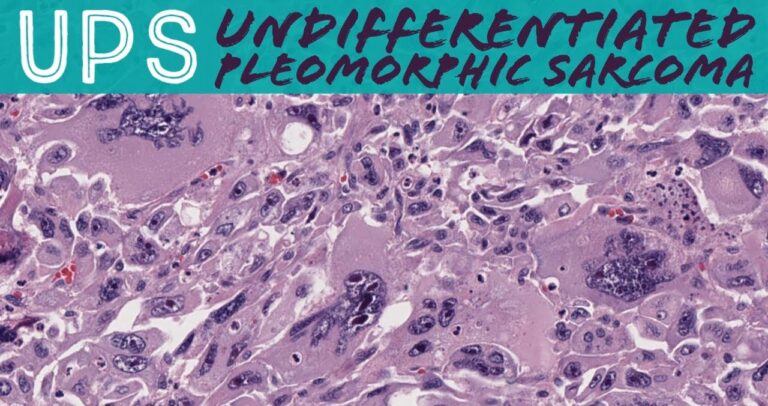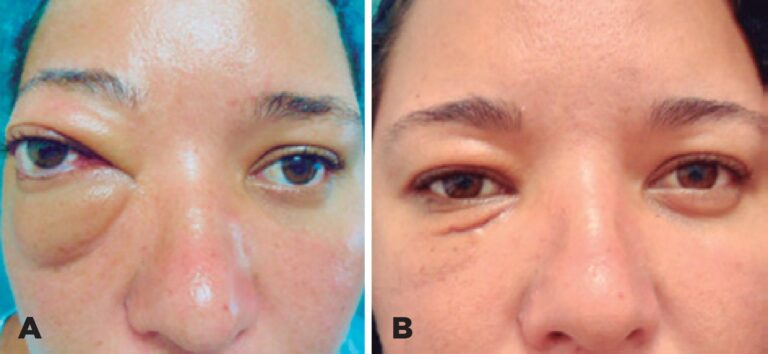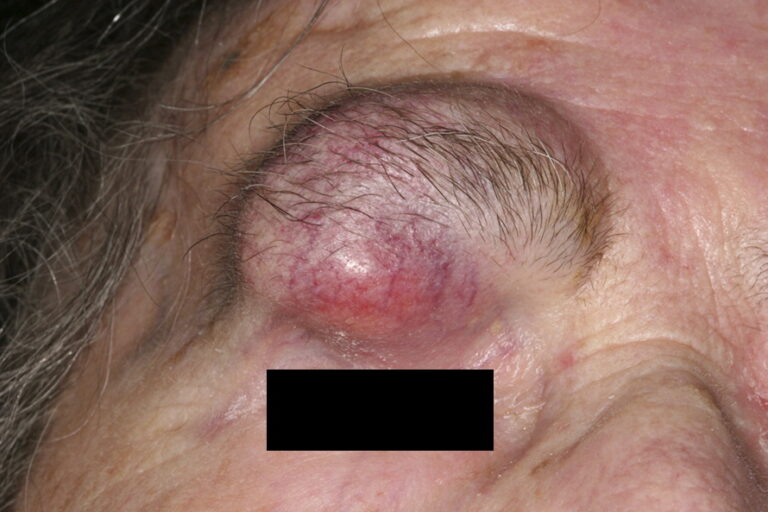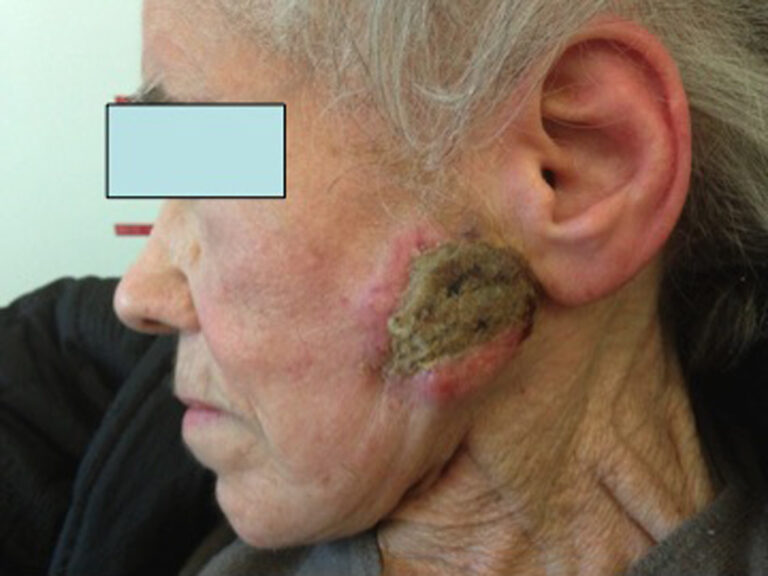UNDIFFERENTIATED PLEOMORPHIC SARCOMA – SYMPTOMS, CAUSES, AND TREATMENT
Undifferentiated pleomorphic sarcoma (UPS) is a rare type of cancer that starts mostly in the soft tissues of the body. Soft tissues join, support, and surround other body structures.
UPS generally happens in the arms or legs. Less often it could happen in the area behind the abdominal organs (retroperitoneum).

The name undifferentiated pleomorphic sarcoma comes from how cancer cells appear under the microscope. Undifferentiated means the cells do not look like the body tissues in which they develop. The cancer is known as pleomorphic because the cells grow in multiple shapes and sizes.
Treatment for UPS depends upon the location of cancer but usually involves surgery, radiation, and drug treatments.
UPS used to be known as malignant fibrous histiocytoma.
SYMPTOMS
Undifferentiated pleomorphic sarcoma symptoms depend on where cancer happens. It most usually occurs in the arms and legs, but it could occur anywhere in the body.
Signs and symptoms might include:
- Growing lump or area of swelling
- If it grows very large, there might be pain, tingling, and numbness
- If it happens in an arm or leg, there might be swelling in the hand or foot of an affected limb
- If it happens in the abdomen, there might be a pain, loss of appetite, and constipation
- Fever
- Weight loss

WHEN SHOULD YOU SEE A DOCTOR?
Make an appointment with a doctor if you develop any continuous signs or symptoms that worry you.
CAUSES
It is not clear what causes undifferentiated pleomorphic sarcoma.
Doctors know this cancer starts when a cell develops changes in its DNA. A cell’s DNA consists of the instructions that tell a cell what to do. The changes tell the cell to multiply quickly, creating a mass of abnormal cells (tumor). The cells could invade and destroy nearby healthy tissue. In time, the cancer cells could break away and spread (metastasize) to other parts of the body, like the lungs and bones.
RISK FACTORS
Factors that might increase the risk of undifferentiated pleomorphic sarcoma include:
- Older age – This cancer tends to happen in adults older than 50, though it could happen at any age.
- Previous radiation therapy – Rarely, this cancer could develop in an area of the body that was previously treated with radiation therapy.
Most people who develop undifferentiated pleomorphic sarcoma do not have any known risk factors, and many people who have risk factors never develop cancer.

DIAGNOSIS
Diagnosis for undifferentiated pleomorphic sarcoma generally begins with a review of your symptoms and a physical exam. This cancer is usually diagnosed after other types of cancer have been ruled out.
Tests and procedures might include:
- Physical examination – Your doctor will ask you questions about when your symptoms started and if they have changed over time. He or she will examine the area to better understand the size and depth of the growth, whether it is attached to nearby tissues, and whether there are any signs of swelling or nerve damage.
- Imaging tests – Your doctor might recommend imaging tests to create images of the affected area and understand more about your condition. Imaging tests might include X-rays, CT, MRI, and positron emission tomography (PET) scans.
- Removing a sample of tissue for testing (biopsy) – To make a definitive diagnosis, your doctor collects a sample of the tumor tissue and sends it to a laboratory for testing. Depending on your particular situation, the tissue sample might be collected with a needle inserted through your skin or during an operation.
In the laboratory, doctors trained in analyzing body tissues (pathologists) examine the sample to find out the types of cells involved and whether the cells are likely to be aggressive. This information helps rule out other kinds of cancer and guides your treatment.
Determining the type of biopsy required and the specifics of how it should be performed needs careful planning by the medical team. Doctors need to perform the biopsy in a way that would not interfere with future surgery to remove cancer. For this reason, ask your doctor for a referral to a team of experts with extensive experience in treating soft tissue sarcomas prior to the biopsy.
TREATMENT
Treatment for undifferentiated pleomorphic sarcoma generally involves surgery to remove the cancer cells. Other options include radiation therapy and drug treatments (systemic therapies), like chemotherapy, targeted therapy, and immunotherapy. Which treatments are best for you will depend upon the size and location of your cancer.
Surgery
When possible, doctors try to remove the sarcoma fully with surgery. The aim is to remove cancer and a margin of healthy tissue around it with as minimal an impact as possible.
When cancer affects the arms and legs, surgeons prefer using limb-sparing operations. However, in some cases, it might be necessary to amputate the affected arm or leg. Other treatments, like radiation therapy and chemotherapy, may be recommended before surgery to shrink cancer so that it is easier to remove without amputating the affected limb.

Radiation therapy
Radiation therapy uses high-powered beams of energy, like X-rays or protons, to kill cancer cells. Radiation therapy could be given as:
- External beam radiation – This type of radiation comes from a machine that moves around you as you lie down on a table. The machine directs the radiation to exact points on your body.
Radiation might be used before surgery to shrink a sarcoma and make it easier to remove. It might also be used after surgery to kill any cancer cells that remain. - Intraoperative radiation therapy (IORT) – IORT is used during surgery right after the cancer is removed. The radiation is directed to the region around where cancer used to be. IORT may be recommended if the cancer is located in an area that makes it hard to remove cancer completely during surgery.
Chemotherapy
Chemotherapy is a drug treatment that makes use of chemicals to kill cancerous cells. It could be administered by pill or through a vein (intravenously), or both.
Chemotherapy is most usually used to treat undifferentiated pleomorphic sarcoma that comes back after initial treatment or that spreads to other areas of the body.
Sometimes chemotherapy is used prior to surgery to shrink cancer so that it is easier to remove during an operation.
Chemotherapy might also be combined with radiation.
Targeted drug therapy
Targeted drug treatments concentrate on certain abnormalities present within cancer cells. By obstructing these abnormalities, targeted drug treatments could cause cancer cells to die.
For undifferentiated pleomorphic sarcoma, targeted therapy drugs might be combined with chemotherapy.
Some targeted therapies only work in people whose cancer cells have specific genetic mutations. Your cancer cells might be tested in a laboratory to see if these drugs may help you.
Immunotherapy
Immunotherapy makes use of your immune system to fight cancer. Your body’s disease-fighting immune system might not attack your cancer because the cancer cells produce proteins that help them hide. Immunotherapy works by intruding with that process.
Immunotherapy treatments are usually reserved for people with advanced cancer.
If you or anyone you know is suffering from undifferentiated pleomorphic sarcoma, our expert providers at Specialty Care Clinics will take care of your health and help you recover.
Call us on (469) 545-9983 to book an appointment with our specialists.
